Wickham is a large village and civil parish in Hampshire, England, about three miles north of Fareham. At the 2001 census, it had a population of 4,816, falling to 4,299 at the 2011 Census.
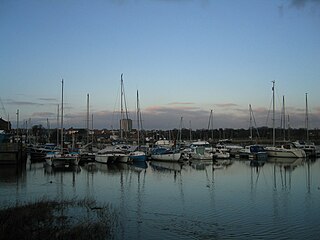
Fareham is a market town at the north-west tip of Portsmouth Harbour, between the cities of Portsmouth and Southampton in south east Hampshire, England. It gives its name to the Borough of Fareham. It was historically an important manufacturer of bricks, used to build the Royal Albert Hall, and grower of strawberries and other seasonal fruits. Current employers include Fareham Shopping Centre, small-scale manufacturers, HMS Collingwood and the Defence Science and Technology Laboratory.

Gosport is a town and non-metropolitan borough on the south coast of Hampshire, South East England. At the 2011 Census, its population was 82,662. Gosport is situated on a peninsula on the western side of Portsmouth Harbour, opposite the city of Portsmouth, to which it is linked by the Gosport Ferry. Gosport lies south-east of Fareham, to which it is linked by a Bus Rapid Transit route and the A32. Until the last quarter of the 20th century, Gosport was a major naval town associated with the defence and supply infrastructure of Her Majesty's Naval Base (HMNB) Portsmouth. As such over the years extensive fortifications were created.

Portchester is a locality and suburb 6 km (4 mi) northwest of Portsmouth, England. It is part of the borough of Fareham in Hampshire. Once a small village, Portchester is now a busy part of the expanding conurbation between Portsmouth and Southampton on the A27 main thoroughfare. Its population according to the 2011 United Kingdom census was 17,789 residents.

The Borough of Fareham is a local government district with borough status and unparished area in Hampshire, England. Its council is based in Fareham. Other places within the borough include Portchester, Hill Head, Stubbington, Titchfield, Warsash, Locks Heath, Sarisbury and half of Whiteley. The borough covers much of the semi-urban area between the cities of Southampton and Portsmouth, and is part of the South Hampshire conurbation, with many residents commuting to the two cities for employment.
Stubbington is a village which is located between Southampton and Portsmouth, in the county of Hampshire on the south coast of England. It is within the borough of Fareham.

Titchfield is a village in southern Hampshire, by the River Meon. The village has a history stretching back to the 6th century. During the medieval period, the village operated a small port and market. Near to the village are the ruins of Titchfield Abbey, a place with strong associations with Shakespeare, through his patron, the Earl of Southampton.

Fareham is a constituency in Hampshire represented in the House of Commons of the UK Parliament. Since 2015, it has been represented by Suella Braverman of the Conservative Party. She is currently the Attorney General for England and Wales.
Catisfield is an area of Fareham, Hampshire, England. Originally a small village in its own right, it has now merged with the western edge of the town.

Funtley – from the Anglo-Saxon, "Funtaleg", "spring field (clearing)", is a hamlet or exurb north of Fareham, Hampshire, England. It forms a projection towards the South Downs National Park and is generally included within Fareham's population as it is within its built-up area. At present the village is unparished, although the creation of a parish council has been discussed.

Titchfield Abbey is a medieval abbey and later country house, located in the village of Titchfield near Fareham in Hampshire, England. The abbey was founded in 1222 for Premonstratensian canons, an austere order of priests. The abbey was a minor house of its order, and became neither wealthy nor influential during its three centuries of monastic life; the inhabitants were devoted to scholarship, as shown by their very impressive library.
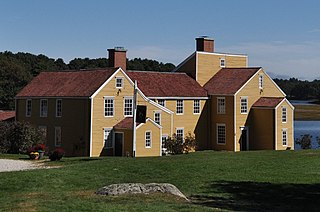
Wentworth–Coolidge Mansion is a 40-room clapboard house which was built as the home, offices and working farm of colonial Governor Benning Wentworth of New Hampshire. It is located on the water at 375 Little Harbor Road, about two miles southeast of the center of Portsmouth. It is one of the few royal governors' residences to survive almost unchanged. The site is a New Hampshire state park, declared a National Historic Landmark in 1968. Today, the New Hampshire Bureau of Historic Sites manages the site with the assistance of the Wentworth-Coolidge Commission, a group of volunteer civic and business leaders appointed by the Governor.
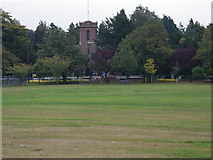
Sarisbury is a village to the west of Park Gate within the borough of Fareham, Hampshire, in the south of England. Its focal point is Sarisbury Green and the parish church of St Paul, formerly part of Titchfield parish. In previous times it was a rural locality dependent on fruit growing. At the 2011 Census the population of the ward was 7,385. Nearby villages include Bursledon, Hamble-le-Rice and Swanwick.
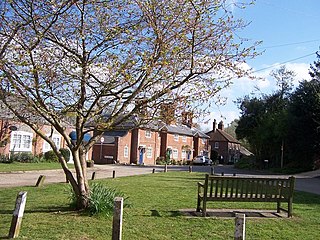
Hook is a hamlet lying within the Borough of Fareham, in south Hampshire, England. It was part of the civil parish of Hook, sometimes known as Hook-with-Warsash, until 1932, when the parish was abolished and became part of Fareham Urban District. In 1931 the parish had a population of 1310.

Fareham Shopping Centre is at the heart of the centre of the medium-sized Hampshire town of Fareham. Built in two phases between 1975 and 1981, the centre contains many well known retailers and is quite large for a town of its size. The shopping centre is part of a wider scheme of buildings in the town centre that were constructed around the same time.
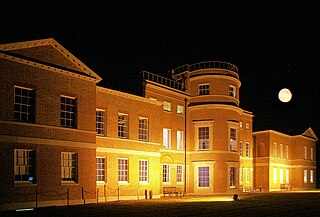
Cams Estate is a 400-acre private estate in Fareham UK. The estate is mainly surrounded by tidal waters and is located at the northern extremity of Fareham Creek. Today it's a golf course and business park with a strong technology theme among the business residents.
Sir Thomas Badd, 1st Baronet was an English Royalist soldier.
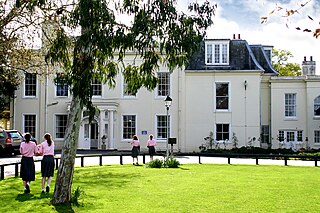
West Hill Park School is an independent, coeducational, day and boarding school for boys and girls aged 3 years to 13 years. It is situated in Fareham, England close to the Hampshire coast, between Southampton and Portsmouth.
Coldeast is a former manor house and former psychiatric hospital between Park Gate and Sarisbury in Hampshire, England. The house is used today as a wedding and conference venue and much of the former grounds are being redeveloped for housing and the construction of a new leisure centre.















